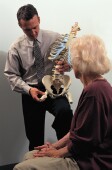Residual life expectancy for 50- and 75-year-old man starting treatment estimated at 18.2 and 7.5 years
FRIDAY, Feb. 13, 2015 (HealthDay News) — Women and men below age 70 who are treated for osteoporosis have an excess mortality risk, according to a study published online Feb. 7 in the Journal of Bone and Mineral Research.
Bo Abrahamsen, M.D., Ph.D., from Glostrup Hospital in Denmark, and colleagues conducted an observational study tracking prescriptions for osteoporosis drugs, comorbid conditions, and deaths. Data were included for 58,637 patients and 225,084 age- and gender-matched controls. Patients were followed until the end of 2013, for a follow-up period of 10 to 17 years.
The researchers found that the relative risk of dying decreased from being strongly elevated in the first year to a stable but elevated level in subsequent years among men below age 80 and women below age 60. There was only a small increase in risk in the first year of treatment for women aged older than 65 to 70 years, followed by mortality that was lower than background mortality. For a 50-year-old man beginning osteoporosis treatment, the residual life expectancy was estimated at 18.2 years, whereas for a 75-year-old man it was 7.5 years. For women, the corresponding residual life expectancy numbers were estimated at 26.4 and 13.5 years.
“This study shows an excess mortality in men and in women below age 70 who are treated for osteoporosis, compared with the background population,” the authors write. “This excess risk is more pronounced in the first few years on treatment.”
The study was funded by Novartis, Nycomed/Takeda, NPS Pharmaceuticals, and Amgen; two authors disclosed financial ties to the pharmaceutical industry.
Copyright © 2015 HealthDay. All rights reserved.








